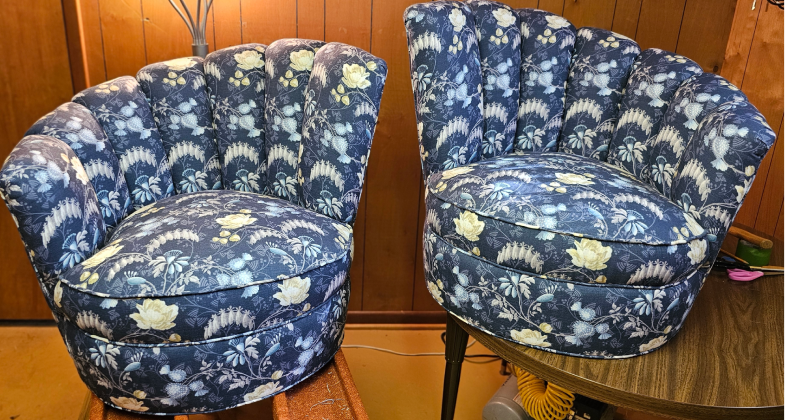🌞🌼 Call: 218 234 2852 🌼🌞
Repeating Patterns in Upholstery: Approaches to Matching and Enhancing Design

Repeating Patterns in Upholstery: Approaches to Matching and Enhancing Design
Upholstery plays a crucial role in interior design, not only providing comfort but also contributing significantly to the aesthetic appeal of furniture. One of the key elements in upholstery is the use of repeating patterns, which can range from florals and geometrics to stripes and plaids. The art of matching these patterns is essential in creating visually harmonious and professionally finished pieces. This blog post explores the different approaches to working with repeating patterns in upholstery and offers tips for achieving the best results.
Understanding Repeating Patterns
A repeating pattern is a design element that repeats at regular intervals across a fabric. These patterns can vary in complexity and scale, influencing how they are used in upholstery projects. Common types of repeating patterns include:
- Florals: Often feature intricate designs that require careful alignment.
- Geometrics: Include shapes like squares, diamonds, and circles that need precise matching to maintain their symmetry.
- Stripes: Can be horizontal, vertical, or diagonal and require straight alignment to look cohesive.
- Plaids and Checks: Combinations of stripes in different directions, which can be challenging to match perfectly.
Approaches to Pattern Matching
When upholstering furniture, matching the pattern correctly is crucial for a professional and visually pleasing finish. Here are some approaches to consider:
1. Symmetrical Matching
For patterns that have a clear, symmetrical design, such as geometrics or florals, symmetrical matching ensures that the design flows seamlessly across different sections of the furniture. This involves:
- Centralizing the Pattern: Position the main motif or design element at the center of the piece, ensuring that it is mirrored equally on both sides.
- Aligning Seams: Carefully aligning seams so that the pattern matches perfectly where different pieces of fabric meet.
2. Flow Matching
Flow matching is ideal for less symmetrical and more organic patterns, such as abstract designs or large-scale florals. The goal is to create a sense of continuous flow across the upholstered surface:
- Continuity Across Panels: Ensure that the pattern continues naturally from one panel to the next without abrupt changes.
- Visual Balance: Focus on achieving a balanced look, even if the pattern doesn't match perfectly at every seam.
3. Stripe Matching
Stripes can be particularly challenging to match, as any misalignment is easily noticeable. Here are some tips for working with stripes:
- Consistent Direction: Make sure all stripes run in the same direction across the entire piece.
- Aligning Edges: Pay close attention to aligning stripes at the edges and seams to maintain a continuous look.
- Pattern Repeat: Be mindful of the pattern repeat, which is the distance before the stripe pattern repeats itself. Use this measurement to plan your cuts.
4. Plaid and Check Matching
Matching plaids and checks requires careful planning due to their multi-directional patterns. Here's how to approach this:
- Pattern Repeat Awareness: Understand the repeat interval of the plaid or check pattern and use it to align the design accurately.
- Seam Alignment: Focus on aligning both horizontal and vertical lines at seams to maintain the integrity of the pattern.
- Cutting Accuracy: Precision in cutting is essential. Use templates or guides to ensure each piece is cut correctly to match the pattern.
Practical Tips for Successful Pattern Matching
- Plan Ahead: Before cutting, plan the layout of the fabric on the furniture. Consider where the main motifs will be placed and how the pattern will flow across seams.
- Use Templates: Create templates or use tracing paper to outline the pattern on the fabric before cutting. This helps in visualizing the final result and ensuring accuracy.
- Start from the Center: When upholstering large surfaces, start from the center and work your way out. This ensures that the main design elements are centered and symmetrical.
- Take Your Time: Pattern matching requires patience and precision. Take your time to measure, cut, and align the fabric correctly.
- Professional Help: For complex patterns or valuable fabrics, consider seeking professional upholstery services to ensure the best results.
Conclusion
Mastering the art of pattern matching in upholstery can transform a simple piece of furniture into a stunning work of art. Whether you're working with florals, geometrics, stripes, or plaids, understanding the intricacies of pattern repeats and using the right techniques will help you achieve a polished and professional look. By planning ahead, using templates, and taking your time, you can create beautifully upholstered pieces that enhance the aesthetic appeal of any space.
